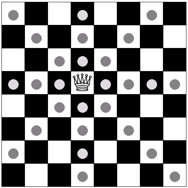Programming contestsECN programozó csapatverseny, 2017. május 13.
May 13, 2017, 10:10 AM –
May 13, 2017, 3:10 PM
|
Queens
On the chessboard, the queen is able to move any number of squares vertically, horizontally, or diagonally (see the figure). Queen A captures queen B if queen A can move to the square of queen B in one step.

There is an N × N chessboard, and there are Q pieces of queens on it. The task is to count how many groups the queens form. Queen A and queen B belong to the same group if they capture each other or there are queens q1, q2, …, qk such that queen A captures queen q1, queen qi captures queen qi + 1 (1 ≤ i < k), and queen qk captures queen B.
Input Specification
The first line of the input contains the number of test cases t (1 ≤ t ≤ 100). The first line of each test case contains two positive integers: N is the size of the chessboard, and Q is the number of queens (1 ≤ N ≤ 109, 1 ≤ Q ≤ min {N × N, 1000}). The next Q lines contain the (xi, yi) coordinates of the queens (0 ≤ xi, yi ≤ N – 1, 1 ≤ i ≤ Q). There are no two or more queens on the same square.
Output Specification
For each test case, the program has to write out into a separate line the number of groups the queens form.
Sample Input
28 50 02 45 40 26 38 32 13 67 5
Output for Sample Input
13